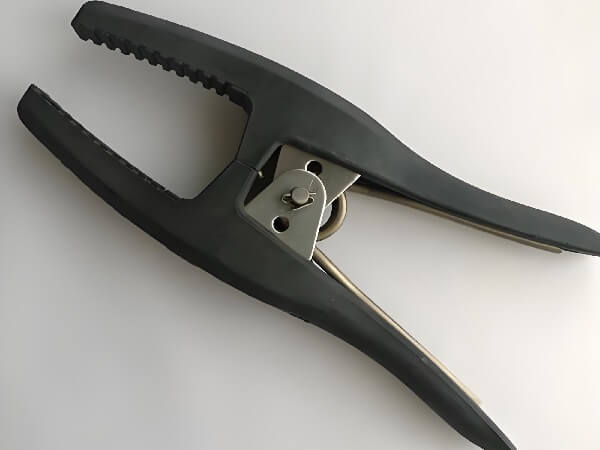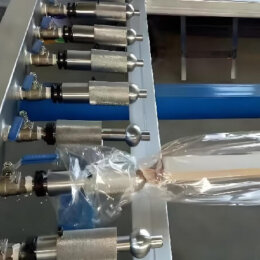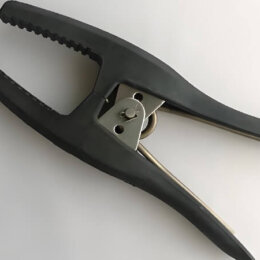The necessity of aluminum profile anodizing non-pneumatic clamp in anodizing process
The necessity of aluminum profile anodizing non-pneumatic clamp in anodizing process
An anodizing non-pneumatic clamp, also known simply as a non-pneumatic clamp, is a type of clamp used in industrial processes such as anodizing, but it does not rely on pneumatic (compressed air) power for operation.
Instead, it may utilize mechanical, hydraulic, or manual mechanisms for clamping.
An aluminum profile anodizing no-pneumatic clamp can be essential in the anodizing process for several reasons:
1. Corrosion Resistance: Anodizing is a process that enhances the corrosion resistance of aluminum profiles by forming a protective oxide layer on their surface.
During the anodizing process, it’s crucial to securely hold the aluminum profiles in place to ensure uniform coating and proper immersion in the anodizing solution.
A reliable clamp is necessary to prevent movement or distortion of the profiles, which could compromise the quality of the anodized finish.
2. Even Coating: Anodizing requires consistent and uniform coating across the entire surface of the aluminum profiles.
A no-pneumatic clamp ensures that the profiles remain firmly fixed in position throughout the anodizing process, preventing any areas from being left exposed or receiving uneven coating due to shifting or movement.
3. Safety: Anodizing solutions can be corrosive and may contain hazardous chemicals.
A secure clamp helps minimize the risk of accidents by preventing accidental spills or splashes that could occur if the profiles were not adequately secured during the anodizing process.
4. Efficiency: Efficient anodizing processes rely on consistent production throughput.
A reliable no-pneumatic clamp facilitates smooth and uninterrupted processing by securely holding the aluminum profiles in place, reducing the likelihood of delays or interruptions due to rework or quality issues caused by improper clamping.
5. Quality Control: Proper clamping ensures that the aluminum profiles maintain their intended shape and dimensions during the anodizing process.
This is essential for meeting quality control standards and ensuring that the finished anodized products meet the desired specifications.
6. Minimization of Waste: Inefficient clamping or inadequate fixation of aluminum profiles can lead to wastage of anodizing solution and other resources.
A non-pneumatic clamp that securely holds the profiles in place helps minimize wastage and optimize resource utilization during the anodizing process.
Overall, an aluminum profile anodizing non-pneumatic clamp plays a crucial role in ensuring the success, efficiency, and safety of the anodizing process by securely holding the profiles in place, facilitating uniform coating, and minimizing the risk of accidents or quality issues.
Here are the features and advantages of an anodizing non-pneumatic clamp:
Features:
Mechanical or Hydraulic Operation: Non-pneumatic clamps may use mechanical levers, screws, or hydraulic systems to apply clamping force to hold workpieces securely.
Manual Adjustment: Some no-pneumatic clamps may require manual adjustment for clamping pressure and positioning. This can involve turning screws or knobs to tighten or release the clamp.
Variety of Designs: Non-pneumatic clamps come in various designs to accommodate different applications and workpiece sizes.
This includes toggle clamps, screw clamps, lever clamps, and hydraulic clamps, among others.
Durable Construction: Like pneumatic clamps, non-pneumatic clamps are often constructed from durable materials such as steel or aluminum to withstand the rigors of industrial environments.
Advantages:
No Need for Compressed Air: Unlike pneumatic clamps, non-pneumatic clamps do not require a source of compressed air for operation.
This can reduce the complexity of the setup and eliminate the need for air compressors and associated maintenance.
Lower Operating Costs: Since they do not rely on compressed air, non-pneumatic clamps can be more cost-effective to operate in the long run, as they typically consume less energy and require fewer components to function.
Simplicity: Non-pneumatic clamps are often simpler in design compared to pneumatic clamps, which can make them easier to maintain and repair.
They may also be easier to operate manually without the need for complex control systems.
Suitability for Certain Environments: In environments where the use of compressed air is not practical or permitted, such as in clean rooms or hazardous areas, non-pneumatic clamps offer a viable alternative for securing workpieces.
Versatility: Non-pneumatic clamps can be adapted for use in a wide range of applications beyond anodizing, including welding, machining, woodworking, and assembly processes.
In summary, an anodizing non-pneumatic clamp provides a reliable and cost-effective solution for securely holding workpieces during industrial processes, offering simplicity, versatility, and durability without the need for compressed air.





